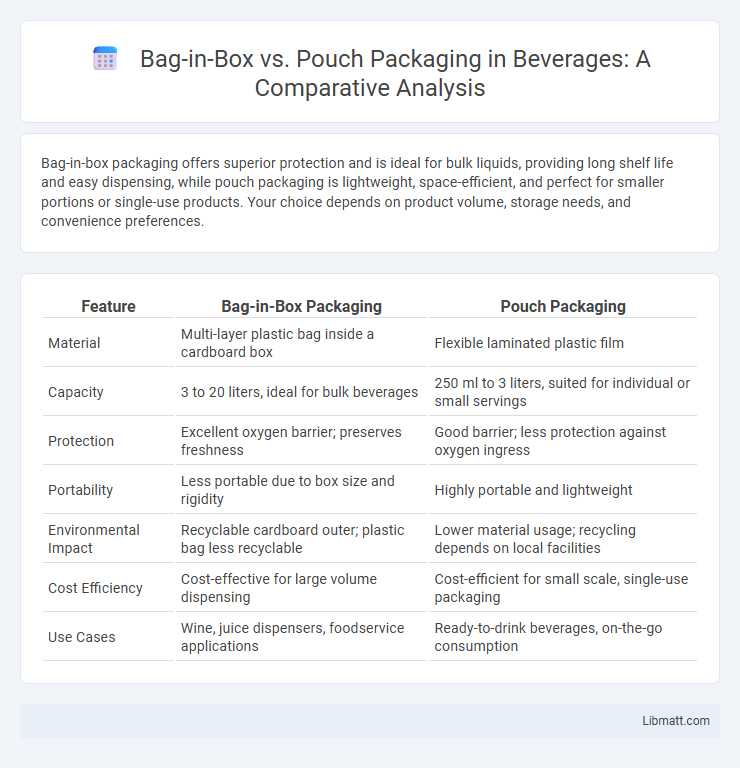Bag-in-box packaging offers superior protection and is ideal for bulk liquids, providing long shelf life and easy dispensing, while pouch packaging is lightweight, space-efficient, and perfect for smaller portions or single-use products. Your choice depends on product volume, storage needs, and convenience preferences.
Table of Comparison
| Feature | Bag-in-Box Packaging | Pouch Packaging |
|---|---|---|
| Material | Multi-layer plastic bag inside a cardboard box | Flexible laminated plastic film |
| Capacity | 3 to 20 liters, ideal for bulk beverages | 250 ml to 3 liters, suited for individual or small servings |
| Protection | Excellent oxygen barrier; preserves freshness | Good barrier; less protection against oxygen ingress |
| Portability | Less portable due to box size and rigidity | Highly portable and lightweight |
| Environmental Impact | Recyclable cardboard outer; plastic bag less recyclable | Lower material usage; recycling depends on local facilities |
| Cost Efficiency | Cost-effective for large volume dispensing | Cost-efficient for small scale, single-use packaging |
| Use Cases | Wine, juice dispensers, foodservice applications | Ready-to-drink beverages, on-the-go consumption |
Introduction to Bag-in-Box and Pouch Packaging
Bag-in-box packaging consists of a flexible plastic bag housed inside a rigid cardboard box, commonly used for liquids like wine and juice, providing durability and easy storage. Pouch packaging features a lightweight, flexible structure made from laminated films, ideal for snacks, beverages, and personal care products, offering convenience and reduced environmental impact. Your choice between bag-in-box and pouch packaging depends on product type, shelf life, and transportation requirements.
Material Composition and Sustainability
Bag-in-box packaging utilizes a combination of corrugated cardboard and multi-layer plastic films, offering robust protection and recyclability when separated properly. Pouch packaging primarily consists of flexible plastic laminates, often incorporating materials like polyethylene, aluminum foil, and nylon, which can be more challenging to recycle due to multi-layer complexity. Sustainability efforts prioritize design innovations aimed at enhancing recyclability and reducing plastic use in both packaging types, with a trend toward bio-based materials and lightweight structures to minimize environmental impact.
Design and Structural Differences
Bag-in-box packaging features a flexible plastic bag housed within a rigid cardboard box, providing sturdy outer protection and ease of stacking, while pouch packaging consists of a sealed, flexible plastic or foil pouch designed for lightweight, compact storage and portability. The bag-in-box design includes a tap or spout integrated into the bag for controlled dispensing, whereas pouches often incorporate resealable zippers or tear notches, enhancing convenience and freshness. Your choice between these options should consider the structural integrity and intended use, as bag-in-box excels in bulk liquid storage with protection, and pouches offer superior space efficiency and flexibility.
Space Efficiency and Storage
Bag-in-box packaging offers superior space efficiency with its rigid outer box optimizing stacking and storage in warehouses and retail environments. Pouch packaging is more flexible and lightweight, enabling easier transport and minimizing storage footprint by conforming to available space. Your choice depends on storage constraints and the need for maximizing shelf space or reducing shipping volume.
Product Protection and Shelf Life
Bag-in-box packaging offers superior product protection due to its rigid outer box that prevents punctures and physical damage, significantly extending shelf life by limiting oxygen exposure. Pouch packaging is lightweight and flexible but generally provides less barrier protection, which may result in shorter shelf life, especially for oxygen-sensitive products. You should consider bag-in-box for longer storage and extended freshness, while pouches suit quicker consumption or less sensitive items.
Ease of Use and Consumer Convenience
Bag-in-box packaging offers superior ease of use with its integrated tap system, allowing consumers to dispense liquids smoothly without spills. Pouch packaging provides lightweight convenience and portability, ideal for on-the-go consumption but may require careful handling to avoid leaks. Consumers seeking mess-free, controlled pouring often prefer bag-in-box, while those valuing compact storage and flexibility lean towards pouches.
Cost Comparison and Economic Impact
Bag-in-box packaging often provides a more cost-effective solution for bulk liquid storage due to lower material and transportation expenses, making it popular in industries like wine and juice. Pouch packaging, while generally offering higher flexibility and less storage space, tends to have higher per-unit costs and is better suited for smaller volume distribution. Economically, choosing bag-in-box can reduce supply chain expenses significantly, whereas pouches may increase packaging costs but improve consumer convenience and shelf appeal.
Market Applications and Industry Trends
Bag-in-box packaging dominates the beverage and food industries due to its large capacity and cost-effectiveness in bulk storage, making it ideal for wine, juice, and liquid dairy products. Pouch packaging is gaining traction in retail and single-use markets, especially for snacks, sauces, and personal care items, driven by consumer demand for convenience and portability. Your choice depends on market application requirements; bag-in-box suits large-scale use, whereas pouches align with on-the-go consumption trends and sustainable packaging initiatives.
Environmental Impact and Recycling
Bag-in-box packaging typically uses a sturdy cardboard outer box combined with a plastic bladder, which results in reduced plastic waste and allows for easier recycling of the cardboard component compared to standalone pouches. Pouch packaging is lightweight and requires less material, which lowers transportation emissions, but its multi-layer plastic films often hinder recycling efforts in many facilities. You can improve environmental impact by choosing bag-in-box options that support efficient recycling or deciding based on local recycling capabilities for pouches.
Choosing the Right Packaging Solution
Choosing the right packaging solution depends on your product's shelf life, convenience, and environmental impact. Bag-in-box packaging offers superior protection against oxidation and is ideal for large quantities, while pouch packaging excels in portability and space efficiency for smaller servings. Evaluate your distribution needs and consumer preferences to ensure your packaging enhances product preservation and user experience.
Bag-in-box vs pouch packaging Infographic

 libmatt.com
libmatt.com